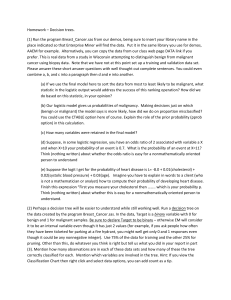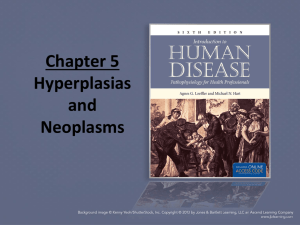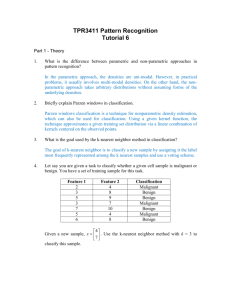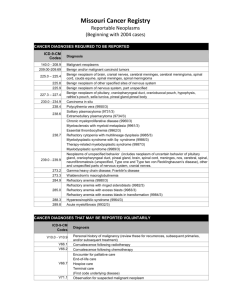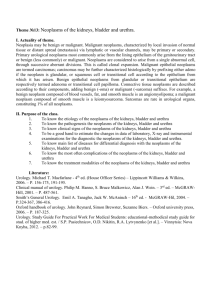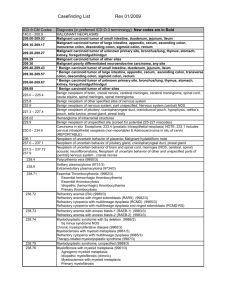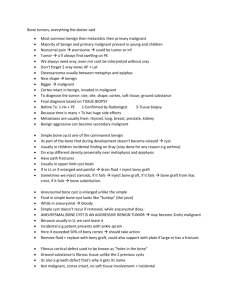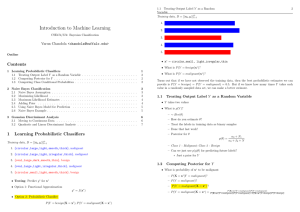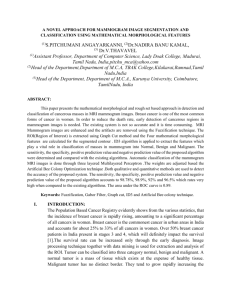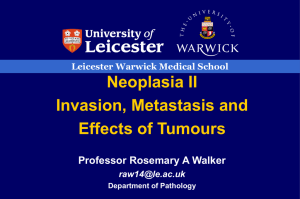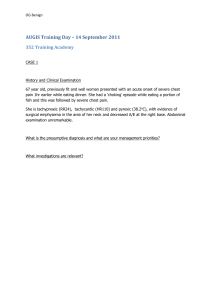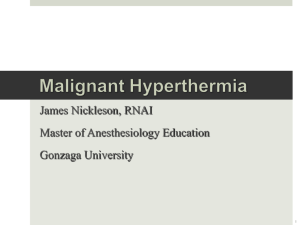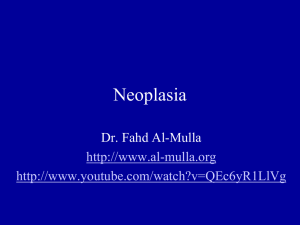Lecture 9
advertisement
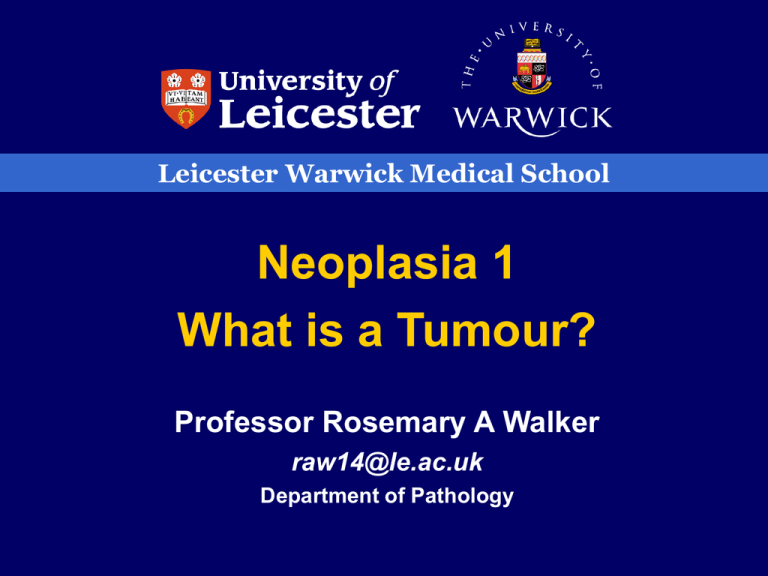
Leicester Warwick Medical School Neoplasia 1 What is a Tumour? Professor Rosemary A Walker raw14@le.ac.uk Department of Pathology WHAT IS A TUMOUR? a swelling inflammatory – abscess neoplasm - growth NEOPLASM • Abnormal growth of cells which persists after initiating stimulus has been removed • Cell growth has escaped from normal regulatory mechanisms • Benign • Malignant BENIGN NEOPLASM Cells grow as a compact mass and remain at their site of origin MALIGNANT NEOPLASM Growth of cells is uncontrolled Cells can spread into surrounding tissue and spread to distant sites Cancer = a malignant growth HOW DO TUMOURS DEVELOP? • There has to be a change to DNA • The change must cause an alteration in cell growth and behaviour • The change must be non-lethal and be passed onto daughter cells HOW DO TUMOURS DEVELOP? • Alteration is to more than one gene • Genes concerned are oncogenes/tumour suppressor genes • Sequence of gene alterations from normal to benign to malignant • Intrinsic and extrinsic / inheritance and environment key factors CLONALITY Alterations in genes regulating growth and behaviour occur in every cell – monoclonal population Evidence from studying G6PD In heterozygotes cells contain either G6PD A or G6PD B, but tumours in those people consist of cells that all have the same enzyme A B B A A NORMAL A A A B B OR B CANCER B HOW DO NEOPLASTIC CELLS DIFFER FROM NORMAL CELLS? Alterations in growth control • proliferation • cell death • factors regulating growth and response Alterations in cellular interactions • cell-cell • cell-stroma GROWTH CONTROL • Increased cell proliferation more cells enter cell cycle cell cycle “speeded up” • Cells have changed life span • Alterations in cell death-decreased apoptosis • Modification of cell metabolism • Angiogenesis GROWTH CONTROL • Increased or decreased growth factor receptors or altered receptors • Synthesis of growth factors – autocrine or paracrine effect • Excess/modified growth control proteins e.g. oncoproteins Autocrine Increased DNA synthesis and proliferation Growth factor receptor Paracrine = Growth factor CELLULAR INTERACTIONS Cell-cell interactions Cell-stromal interactions with basement membrane Important for cell and tissue differentiation, embryogenesis, growth regulation Desmosomes Ordered Cytoskeleton Basement membrane Cell receptors Disorganised Cytoskeleton Loss of cell receptors DIFFERENCES BETWEEN BENIGN AND MALIGNANT NEOPLASMS • • • • • Size Growth characteristics Vascularity/necrosis Function Invasion/metastasis DIFFERENCES BETWEEN BENIGN AND MALIGNANT NEOPLASMS BENIGN MALIGNANT Nuclear variation in size Nuclear variation in size and shape minimal and shape minimal to marked, often variable Diploid Range of ploidy Low mitotic count, normal mitosis Low to high mitotic count, abnormal mitosis Retention of specialisation Loss of specialisation DIFFERENCES BETWEEN BENIGN AND MALIGNANT NEOPLASMS BENIGN MALIGNANT Structural differentiation Structural differentiation retained shows wide range of changes Organised Not organised Functional differentiation usually Functional differentiation often lost DYSPLASIA • • • • • • Premalignant condition Increased cell growth Cellular atypia Altered differentiation Can range from mild to severe Sites -cervix -bladder -stomach IN-SITU MALIGNANCY Epithelial neoplasm with features of malignancy • altered cell growth • cytological atypia • altered differentiation BUT-no invasion through basement membrane POSSIBLE EVENTS Benign Benign Benign Dysplasia Benign Dysplasia In-situ Dysplasia In-situ In-situ Invasive Benign Dysplasia In-situ Invasive Invasive Invasive Invasive TYPES OF NEOPLASMS Benign Malignant Epithelial Connective tissue Lymphoid /haemopoietic Germ cell BENIGN EPITHELIAL NEOPLASMS Papilloma • squamous • transitional Adenoma • glandular MALIGNANT EPITHELIAL NEOPLASMS Carcinomas Squamous: skin Transitional: bladder Adeno: stomach, colon Basal cell: skin CONNECTIVE TISSUE NEOPLASMS Smooth muscle: Fibrous tissue: Bone: Cartilage: Fat: Nerve: Nerve sheath: Glial cells: Leiomyoma Fibroma Osteoma Chondroma Lipoma Neurofibroma Neurilemmoma Glioma CONNECTIVE TISSUE NEOPLASMS Smooth muscle: Bone: Fibrous tissue: Cartilage: Fat: Nerve: Nerve sheath: Glial cells: Leiomyosarcoma Osteosarcoma Fibrosarcoma Chondrosarcoma Liposarcoma Neurofibrosarcoma Neurilemmosarcoma Malignant glioma LYMPHOID Malignant lymphoma (B and T) Hodgkins Disease BONE MARROW Acute and chronic leukaemia GERM CELL Testis Teratoma Seminoma Ovary Dermoid Cyst
